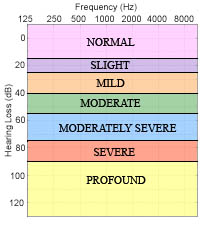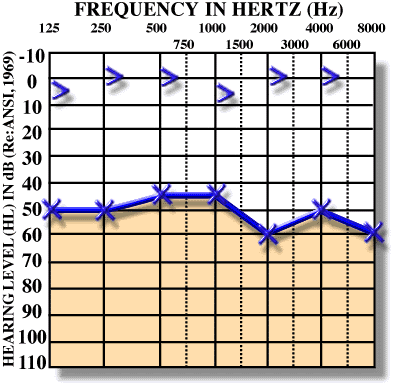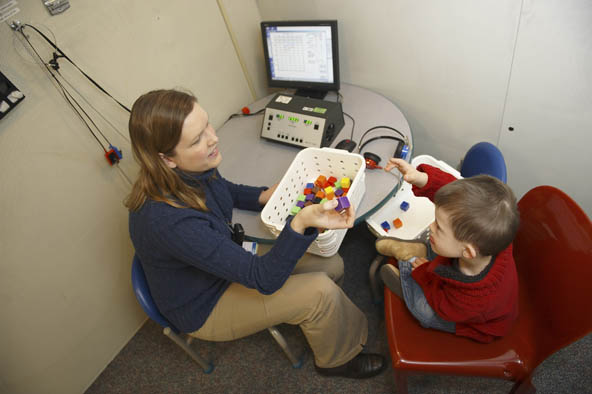The Audiogram
An audiogram shows the softest sounds a person can hear at different frequencies (pitches). The hearing threshold is determined to be the lowest intensity (dBHL) at which multiple presentations of a frequency specific tone were detected 50% of the time. Normal hearing is defined as having threshold at an intensity of 15dB HL or less. The diagram to the right displays different degrees of hearing loss. Normal hearing is defined as having threshold at an intensity greater than or equal to 15dB HL. The diagram to the right displays different degrees of hearing loss.
The frequencies displayed on the horizontal axis of the audiogram are those most crucial to hearing and understanding conversation, with low frequencies on the left and higher frequencies on the right. For example, the sound “sss†presents at a high frequency, while an “ooo†presents at a lower frequency. The shaded region on the audiogram shows the range where most conversational speech occurs.
Information on audiograms is encoded using symbols, each of which represents a different test condition. The first major distinction is between the left and right ear. In general, a red “O†is used to represent the right ear while a blue “X†represents the left ear. Different symbols can be used to denote different test conditions and responses in each ear; if the response was unmasked (i.e. “Xâ€), masked, or vibrotactile. When sound is presented to the test ear in certain conditions, the non-test ear can be stimulated via bone vibrations within the skull. Stimulation of the contralateral ear during a hearing test is referred to as cross hearing. Masking is used to prevent cross hearing. Masking refers to the presentation of noise, at a predetermined level, to the non-test ear. This prevents the non-test ear from hearing the test sound. Vibrotactile symbols refer to responses likely elicited by the vibration of a transducer. Sometimes a patient indicates feeling the stimulus rather than hearing it. In cases where a child will not or cannot wear earphones for ear-specific threshold testing, sounds may be presented via speakers (in the “soundfieldâ€). This technique enables audiologists to draw general conclusions about a child’s hearing but does not give any ear-specific information. Arrows connected to audiogram symbols indicate a no response value, indicating that at the specified frequency no response was detected. Please refer to the audiogram key present on each audiogram for more information. The Guidelines for Audiometric Symbols can be found on the website of the American Speech-Language-Hearing Association (ASHA).
Audiologists present stimuli via bone and air conduction to determine the type of hearing loss. Air conduction testing involves the use of headphones, insert earphones, or speakers to deliver sounds to the ear canal through the middle ear and into the inner ear. Thus, air conduction gives information about how the ear as a whole responds to sound. In bone conduction testing a bone oscillator is placed behind the ear on the mastoid bone to deliver sounds directly to the inner ear by vibration, bypassing the outer and middle ear. Comparing air conduction and bone conduction thresholds helps determine whether a hearing loss is classified conductive, sensorineural, or mixed.
When the outer or middle ear is blocked or damaged, bone conduction thresholds will be better than air conduction hearing levels. Conductive hearing loss is defined as air conduction thresholds greater than 15 dB (outside the normal range) with bone conduction thresholds within the normal range. To the right is an audiogram of an individual with conductive hearing loss in the left ear. Notice that air conduction results show a moderate hearing loss while bone conduction results show that the cochlea and sensorineural pathway are responding within the range of normal hearing sensitivity.
Sensorineural hearing loss occurs when there is damage to the cochlea or to the auditory nerve pathways. Air conduction and bone conduction thresholds are similar and are both outside the normal range. To the left is an audiogram of an individual with sensorineural hearing loss. Notice that bone conduction results are the same as air conduction results and both results demonstrate a mild hearing loss.
Test method and desired patient response is determined by patient age and developmental level. Consistent, reliable behavioral threshold testing is possible with children as young as 6 months developmental age.
Infant & Toddlers: Children as young as 6 months old will reliably turn their head when they hear sounds, like someone calling their name. Visual Reinforcement Audiometry (VRA) is the behavioral test method of choice for children with a developmental age of 6 months – 2 ½ years. VRA uses a conditioned response paradigm. In a sound-treated room, an audiologist can quickly train a child to look towards something interesting like a puppet or video when a sound is heard (i.e. speech, tone, noise burst).
To do this test, the child typically sits in a caregiver’s lap or in a high chair. Sounds are presented through speakers or earphones. When the child hears a sound, he or she turns in response and is rewarded with a dancing puppet or cartoon video clip
As children approach age 2 ½ years, VRA is no longer effective because it cannot hold the child’s interest for the duration of the test. Audiologists have other test methods for older children.
Preschool: At 2 ½ years of age, most children learn games used in conditioned play audiometry (CPA). The child is taught to perform simple tasks in response to a sound. Traditionally, the test setting involves the child and the audiologist sitting at a small table in a sound booth. The child is trained to respond to a stimulus by performing a task such as putting block in a bucket or a peg in a board. After a brief training period where the child demonstrates an understanding of the task, testing begins. Using different games and social praise, the child often plays long enough to determine threshold for several sounds.
School-aged Children: At around age 4 years, children are ready to respond in a more adult-like manner known as a voluntary response. Children are often asked to push a button or raise their hand when they hear a sound.






